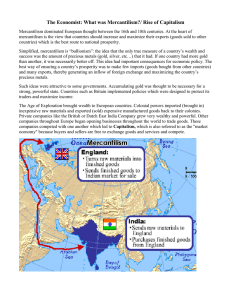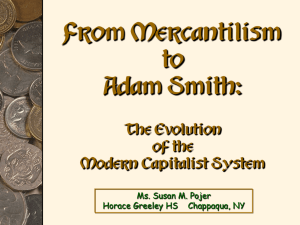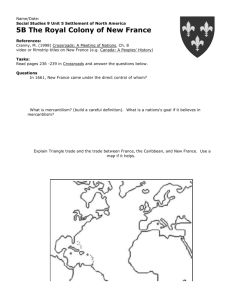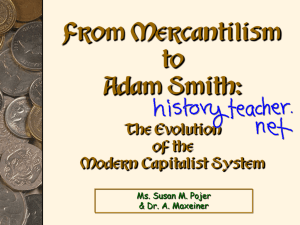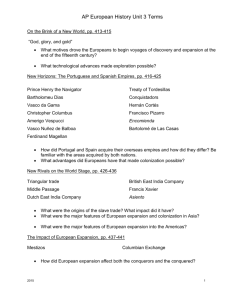From Mercantilism to Adam Smith: The Evolution of the Modern
advertisement
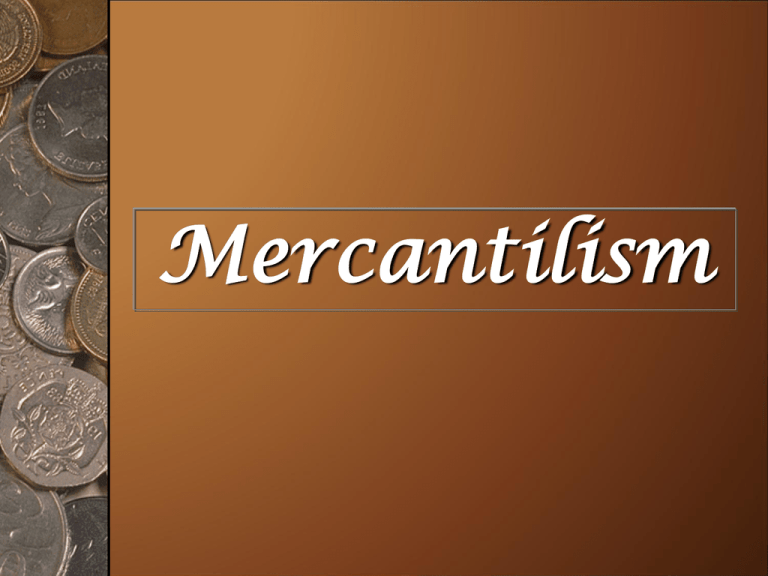
Mercantilism Characteristics of Mercantilism 1. “Bullionism” the economic health of a nation could be measured by the amount of precious metal [gold or silver] which it possessed. ‘Hard’ money was the source of prosperity, prestige, and strength for a nation. Bullionism dictated a “favorable balance of trade.” Export more than you import [a trade surplus]. High tariffs on imported manufactured good. Low tariffs on imported raw materials. Characteristics of Mercantilism 2. Each nation must try to achieve economic self-sufficiency. Those founding new industries should be rewarded by the state. 3. Thriving agriculture should be carefully encouraged. Less of need to import foods. Prosperous farmers could provide a base for taxation. Characteristics of Mercantilism 4. Sea power was necessary to control foreign markets. Less need to use the ships of other nations to carry your trade goods. Your own fleet adds to the power and prestige of the nation. 5. Impose internal taxes of all kinds. Characteristics of Mercantilism 6. Colonies would provide captive markets for manufactured goods & sources of raw materials. Manufactured goods Mother Country Colony Cheap Labor Raw materials 7. Trade is a “zero-sum” game. A nation can gain in international trade only at the expense of other nations. Characteristics of Mercantilism 8. A large population was needed to provide a domestic labor force to people the colonies. 9. Luxury items should be avoided They took money out of the economy unnecessarily. 10.State action was needed to regulate and enforce all of these economic policies. State-sponsored trade monopolies. Mercantilist Goals discovery exploration trade exploitation of resources monopolies of resources Who Benefited Most From Mercantilism? Monarchs. Merchant capitalists. Joint-stock companies. Government officials. Atlantic Economy in the mid-18th Century Capitalism Adam Smith The Wealth of Nations (1776) Adam Smith’s Attack on Mercantilism He was making a political argument, NOT an economic one. Part of the argument was for new economic policy, but an essential part of the argument was for new social and political arrangements. He was against the belief that trade was a zero-sum game It was a positive-sum game. Both nations gained. Basic Capitalist Principles 1. Goods and services are produced for profitable exchange. 2. Human labor power is a commodity for sale LABOR IS THE SOURCE OF VALUE. Goods & Service Consumer Spending Businesses Households Wages Labor & Investments Basic Capitalist Principles 3. Individuals seeking success are driven by self-interest Profit Motive 4. The Law of Supply and Demand Individuals who are free to pursue their self-interest will produce goods and services that others want, at prices others will be willing to pay. Basic Capitalist Principles Basic Capitalist Principles 5. Law of Competition The competitive market system compels producers to be increasingly efficient, and to respond to the desires of consumers. 6. A social division of labor will maximize the satisfaction of individual wants and needs, given scarce resources. Basic Capitalist Principles 7. Laissez faire: Government should interfere minimally with the free and efficient workings of the market Basic Capitalist Principles 8. The “Invisible Hand” of the market Problem How do we survive in a world where we must depend on many others, but where humans are by nature self-interested individuals?? Solution the free market, while appearing chaotic and unrestrained, is actually guided to produce the right amount and variety of goods by a so-called “invisible hand.” Therefore, the basic market mechanism is self-regulating!

